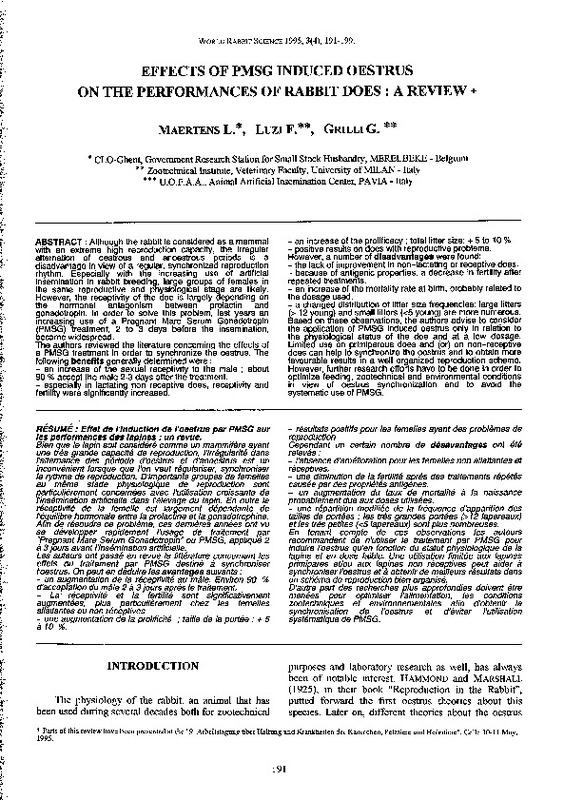JavaScript is disabled for your browser. Some features of this site may not work without it.
Buscar en RiuNet
Listar
Mi cuenta
Estadísticas
Ayuda RiuNet
Admin. UPV
EFFECTS OF PMSG INDUCED OESTRUS ON THE PERFORMANCES OF RABBIT DOES : A REVIEW +
Mostrar el registro sencillo del ítem
Ficheros en el ítem
| dc.contributor.author | Maertens, L.
|
|
| dc.contributor.author | Luzi, F.
|
|
| dc.contributor.author | Grilli, G.
|
|
| dc.date.accessioned | 2011-03-21T13:46:23Z | |
| dc.date.available | 2011-03-21T13:46:23Z | |
| dc.date.issued | 1995 | |
| dc.identifier.issn | 1257-5011 | |
| dc.identifier.uri | http://hdl.handle.net/10251/10495 | |
| dc.description.abstract | [EN] Although the rabbit is considered as a mammal with an extreme high reproduction capacity, the irregular alternation of oestrous and anoestrous periods 1s a disadvantage in view of a regular, synchronized reproduction rhythm. Especially with the increasing use of artificial insemination in rabbit breeding, large groups of females in the same reproductive and pllysiolog1cal stage are likely. However, the receptivity of the tloe is largely aepending on the hormonal antagonism between prolactin and gonadotropin. In order to salve this problem, last years an increasing use of a Pregnant Mare Serum Gonadotropin (PMSG) treatment, 2 to 3 days before the insemination, became widespread. The authors reviewed the literature concerning the effects of a PMSG treatment in arder to synchronize the oestrus. The following beneflts generally determined were : - an increase of the sexual receptivity to the male ; about 90 % accept the male 2-3 days after the treatment. - especially in lactating non receptiva does, receptivity and fertihty were significantly increased. - an increase of the prolificacy ; total litter size: + 5 to 1 O % - positive results on does with reproductiva problems. However, a number of dlsadvantages were found: - the lack of improvement in non-lactating or receptiva does. - because of antigenic properties, a decrease in fertility after repeated treatments. - an increase of the mortality rate at birth, probably related to the dosage used. - a changed distribution of litter size frequencies: larga litters (> 12 young) and small litters (<5 young) are more numerous. Based on these observations, the authors advise to consider the application of PMSG induced oestrus only in relation to the physiological status of the doe and at a low dosage. Limited use on primiparous does and (or) on non-receptiva does can help to synchronize the oestrus and to obtain more favourable results in a well organized reproduction scheme. However, further research efforts have to be done in order to optimize feeding, zootechnical and environmental conditions in view of oestrus synchronization and to avoid the systematic use of PMSG. | es_ES |
| dc.description.abstract | [FR] Bien que le lapin soit considéré comme un mammifere ayant une tres grande capacité de reproduction, l'irrégularité dans l'alternance des p'ériode d'oestrus et d'anoestrus est un inconvénient lorsque que l'on veut régulariser, synchroniser le rythme de reproduction. D'importanls groupes de feme/les au meme stade physiologique de reproduction sont particulierement concernées avec /'utilisation croissante de l'insémination artificielle dans l'élevage du lapin. En outre la réceptivité de la feme/le est largement dépendante de l'équilibre hormona/e entre la prolactine et la gonadotrophine. Afin de résoudre ce probleme, ces dernieres années ont vu se développer rapidement l'usage de traitement par "Prepnant Mare Serum Gonadotropm" ou PMSG, appliqué 2 a 3 JOUrS avant /'insémination artificie/le. Les auteurs ont passé en revue la littérature concernant les effets du traitement par PMSG destiné a synchroniser l'oestrus. On peut en deduire les avantages suivants : - un augmentation de la réceptivité au mate. Enviran 90 % d'accepfation du mate 2 a 3 jours apres le traitement. - La · réceptivité et la fertilité sont significativement augmentées, plus particulierement chez les feme/les allaitantes ou non réceptives - une augmentation de la prolificité ; taille de la portée : + 5 a 10 %. - résultats positifs pour les feme/les ayant des probtemes de reproduction Cependant un certain nombre de désavantages ont été relevés: - /'absence d'amélioration pour les feme/les non allaitantes et réceptives. - une diminution de la fertilité apres des traitements répétés causée par des propriétés antigenes. - un augmentation du taux de mortalité a la naissance probablement due aux doses utilisées. - une répartition modifiée de la fréquence d'apparition des tailles de portées : les tres grandes portées (> 12 lapereaux) et les tres petites (<5 lapereaux) sont plus nombreuses. En tenant compte de ces observations les auteurs recommandent de n'utiliser le traitement par PMSG pour induire l'oestrus qu'en fonction du statut physiologique de la lapine et en dose faible. Une utilisation limitée aux tapines primipares et/ou aux tapines non récepJives peut aider a synchroniser l'oestrus et a obtenir de meilleurs résu/tats dans un schéma de reproduction bien organisé. D'autre part des recherches plus approfondies doivent etre menées pour optimiser l'alimentation, les conditions zootechniques et environnementales afin d'obtenir la synchronisation de l'oestrus et d'éviter l'utilisation systématique de PMSG. | |
| dc.language | Inglés | es_ES |
| dc.publisher | World Rabbit Science. ICTA. UPV | es_ES |
| dc.relation.ispartof | World Rabbit Science | |
| dc.rights | Reserva de todos los derechos | es_ES |
| dc.title | EFFECTS OF PMSG INDUCED OESTRUS ON THE PERFORMANCES OF RABBIT DOES : A REVIEW + | es_ES |
| dc.type | Artículo | es_ES |
| dc.date.updated | 2011-03-21T13:36:01Z | |
| dc.identifier.doi | 10.4995/wrs.1995.262 | |
| dc.rights.accessRights | Abierto | es_ES |
| dc.description.bibliographicCitation | Maertens, L.; Luzi, F.; Grilli, G. (1995). EFFECTS OF PMSG INDUCED OESTRUS ON THE PERFORMANCES OF RABBIT DOES : A REVIEW +. World Rabbit Science. 3(4). https://doi.org/10.4995/wrs.1995.262 | es_ES |
| dc.description.accrualMethod | SWORD | es_ES |
| dc.relation.publisherversion | https://doi.org/10.4995/wrs.1995.262 | |
| dc.description.volume | 3 | |
| dc.description.issue | 4 | |
| dc.identifier.eissn | 1989-8886 | es_ES |








